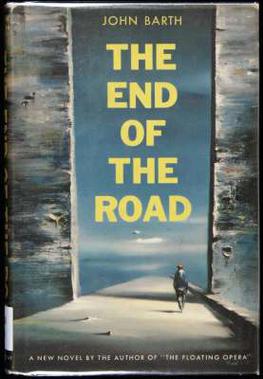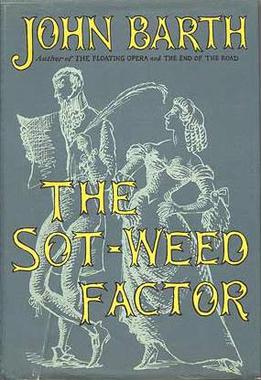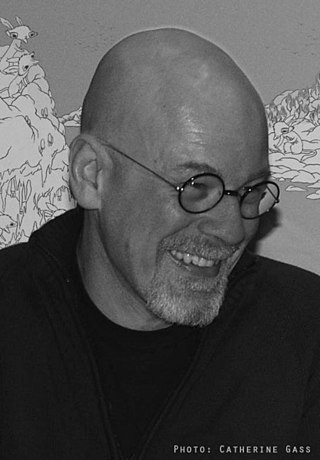Irrealism is a term that has been used by various writers in the fields of philosophy, literature, and art to denote specific modes of unreality and/or the problems in concretely defining reality. While in philosophy the term specifically refers to a position put forward by the American philosopher Nelson Goodman, in literature and art it refers to a variety of writers and movements. If the term has nonetheless retained a certain consistency in its use across these fields and would-be movements, it perhaps reflects the word's position in general English usage: though the standard dictionary definition of irreal gives it the same meaning as unreal, irreal is very rarely used in comparison with unreal. Thus, it has generally been used to describe something which, while unreal, is so in a very specific or unusual fashion, usually one emphasizing not just the "not real," but some form of estrangement from our generally accepted sense of reality.
Postmodernism is an intellectual stance or mode of discourse characterized by skepticism toward the "grand narratives" of modernism; rejection of epistemic (scientific) certainty or the stability of meaning; and sensitivity to the role of ideology in maintaining political power. Claims to objectivity are dismissed as naïve realism, with attention drawn to the conditional nature of knowledge claims within particular historical, political, and cultural discourses. The postmodern outlook is characterized by self-referentiality, epistemological relativism, moral relativism, pluralism, irony, irreverence, and eclecticism; it rejects the "universal validity" of binary oppositions, stable identity, hierarchy, and categorization.

Children's literature or juvenile literature includes stories, books, magazines, and poems that are created for children. Modern children's literature is classified in two different ways: genre or the intended age of the reader, from picture books for the very young to young adult fiction.

Smith of Wootton Major, first published in 1967, is a novella by J. R. R. Tolkien. It tells the tale of a Great Cake, baked for the once in twenty-four year Feast of Good Children. The Master Cook, Nokes, hides some trinkets in the cake for the children to find; one is a star he found in an old spice box. A boy, Smith, swallows the star. On his tenth birthday the star appears on his forehead, and he starts to roam the Land of Faery. After twenty-four years the Feast comes around again, and Smith surrenders the star to Alf, the new Master Cook. Alf bakes the star into a new Great Cake for another child to find.

Naked Lunch is a 1959 novel by American writer William S. Burroughs. The book is structured as a series of loosely connected vignettes, intended by Burroughs to be read in any order. The reader follows the narration of junkie William Lee, who takes on various aliases, from the U.S. to Mexico, eventually to Tangier and the dreamlike Interzone.
Metafiction is a form of fiction that emphasizes its own narrative structure in a way that continually reminds the audience that they are reading or viewing a fictional work. Metafiction is self-conscious about language, literary form, and story-telling, and works of metafiction directly or indirectly draw attention to their status as artifacts. Metafiction is frequently used as a form of parody or a tool to undermine literary conventions and explore the relationship between literature and reality, life, and art.

John Simmons Barth is an American writer who is best known for his postmodern and metafictional fiction. His most highly regarded and influential works were published in the 1960s, and include The Sot-Weed Factor, a whimsical retelling of Maryland's colonial history, Giles Goat-Boy, a satirical fantasy in which a university is a microcosm of the Cold War world, and Lost in the Funhouse, a self-referential and experimental collection of short stories. He was co-recipient of the National Book Award in 1973 for his episodic novel Chimera.
Postmodern literature is a form of literature that is characterized by the use of metafiction, unreliable narration, self-reflexivity, intertextuality, and which often thematizes both historical and political issues. This style of experimental literature emerged strongly in the United States in the 1960s through the writings of authors such as Kurt Vonnegut, Thomas Pynchon, William Gaddis, Philip K. Dick, Kathy Acker, and John Barth. Postmodernists often challenge authorities, which has been seen as a symptom of the fact that this style of literature first emerged in the context of political tendencies in the 1960s. This inspiration is, among other things, seen through how postmodern literature is highly self-reflexive about the political issues it speaks to.
Historiographic metafiction is a term coined by Canadian literary theorist Linda Hutcheon in the late 1980s. It incorporates three domains: fiction, history, and theory.

Lost in the Funhouse (1968) is a short story collection by American author John Barth. The postmodern stories are extremely self-conscious and self-reflexive, and are considered to exemplify metafiction.

The End of the Road is the second novel by American writer John Barth, published first in 1958, and then in a revised edition in 1967. The irony-laden black comedy's protagonist Jacob Horner suffers from a nihilistic paralysis he calls "cosmopsis"—an inability to choose a course of action from all possibilities. As part of a schedule of unorthodox therapies, Horner's nameless Doctor has him take a teaching job at a local teachers' college. There Horner befriends the super-rational Joe Morgan and his wife Rennie. The trio become entangled in a love triangle, with tragic results. The story deals with issues controversial at the time, such as sexuality, racial segregation, and abortion.

The Sot-Weed Factor is a 1960 novel by the American writer John Barth. The novel marks the beginning of Barth's literary postmodernism. The Sot-Weed Factor takes its title from the poem The Sot-Weed Factor: Or, a Voyage to Maryland. A Satyr (1708) by the English-born poet Ebenezer Cooke, about whom few biographical details are known.
Post-postmodernism is a wide-ranging set of developments in critical theory, philosophy, architecture, art, literature, and culture which are emerging from and reacting to postmodernism.

A novel is a relatively long work of narrative fiction, typically written in prose and published as a book. The English word to describe such a work derives from the Italian: novella for "new", "news", or "short story ", itself from the Latin: novella, a singular noun use of the neuter plural of novellus, diminutive of novus, meaning "new". According to Margaret Doody, the novel has "a continuous and comprehensive history of about two thousand years", with its origins in the Ancient Greek and Roman novel, Medieval Chivalric romance, and in the tradition of the Italian Renaissance novella. The ancient romance form was revived by Romanticism, in the historical romances of Walter Scott and the Gothic novel.

Shinto is frequently a theme in Japanese popular culture, including film, manga, anime, and video games. Shinto religion is at the core of Japanese culture and history and as such greatly affects the outcome of pop culture in modern Japan.
The Literature of Exhaustion is a 1967 essay by the American novelist John Barth sometimes considered to be the manifesto of postmodernism.

The Floating Opera is a novel by American writer John Barth, first published in 1956 and significantly revised in 1967. Barth's first published work, the existentialist and nihilist story is a first-person account of a day when protagonist Todd Andrews contemplates suicide.

The Last Voyage of Somebody the Sailor is a novel by American writer John Barth, published in 1991. It is a postmodern metafictional story of a man who jumps overboard from a modern replica of a medieval Arab ship and is rescued by sailors from the world of Sinbad the Sailor. Eventually he makes his way to "Baghdad, the City of Peace", and finds himself in the stories of Sindbad and Scheherazade. The novel makes use of a challenging double-stranded narrative and a rich prose style.

Steve Tomasula is an American novelist, critic, short story, and essay author known for cross-genre narratives that explore conceptions of the self, especially as shaped by language and technology.











